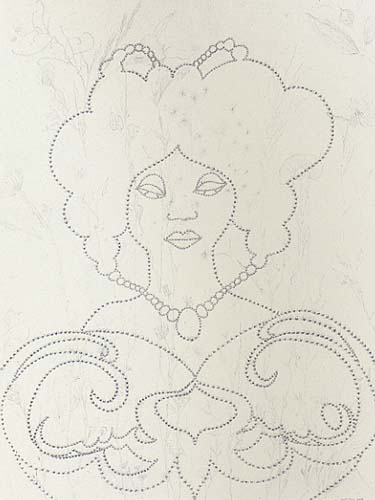-------
(Oct. 11, 2010) After a splash on the London art scene in the 1990s, and an infamous controversy regarding elephant dung and former New York City mayor Rudy Giuliani, painter Chris Ofili quietly relocated to Trinidad in 2005 to remove himself from politics and focus on his art. The Tate Britain, which also presented Ofili with the prestigious Turner Prize in 1998, held a mid-career retrospective of his work earlier this year. With Ofili’s current exhibition, “Afrotranslinear,” The Arts Club presents a more specific survey of more than 100 works on paper created over the last decade.
“Afrotranslinear” is the first Chicago exhibition of Ofili’s art, and his graphic, cartoonish figures present a 1960s and seventies style that aligns remarkably well with Chicago Imagist art. This may be the simplest, most restrained work of Ofili’s to date. As in his most recognizable paintings, his hand still strays toward the intricate and adorned. Yet, in his bright, flat watercolor portraits, and with a reduced palette in his graphite drawings, it is easier to notice the simple beauty and thoughtful humor in his work. With vibrant colors reflecting tropical Trinidad, Ofili’s lush watercolor portraits are crude in execution, yet purposeful in hue. Local flora is inseparable from the portraits, as the brightly patterned clothes seem to grow from the base of the page, flowering in the figures’ heads. The Arts Club’s choice to present solely Ofili’s works on paper is a significant one; they get all of the flashy, secret thrills of “that shit artist” with none of the obvious, immediate scandal.
Ofili’s musings on sexuality and race are most evident in his graphite drawings. The white of the page is primarily left untouched, against which his male and female figures are composed of simple, dotted lines; the tiny dots, upon closer examination, materialize as wide-eyed, afroed faces. Other drawings use these afro-dots in abstract, graphic compositions, the lines becoming hypnotic as undulating waves radiate from the tiny heads. Despite the predominance of the white page, Ofili’s afroed, black figures command the space, and the entire composition transitions into a representation of blackness. Ofili encourages such movement, as the title “Afrotranslinear” suggests: to see and appreciate an all-encompassing black, across and beyond the lines. (Julia V. Hendrickson)
---------------
Also, be sure to check out J. Foumberg's -ahem- tangentally and thematically-related review of the Rebecca Warren exhibit at the Renaissance Society. This may or may not have been dog-eared over at Newcity this week.





No comments:
Post a Comment